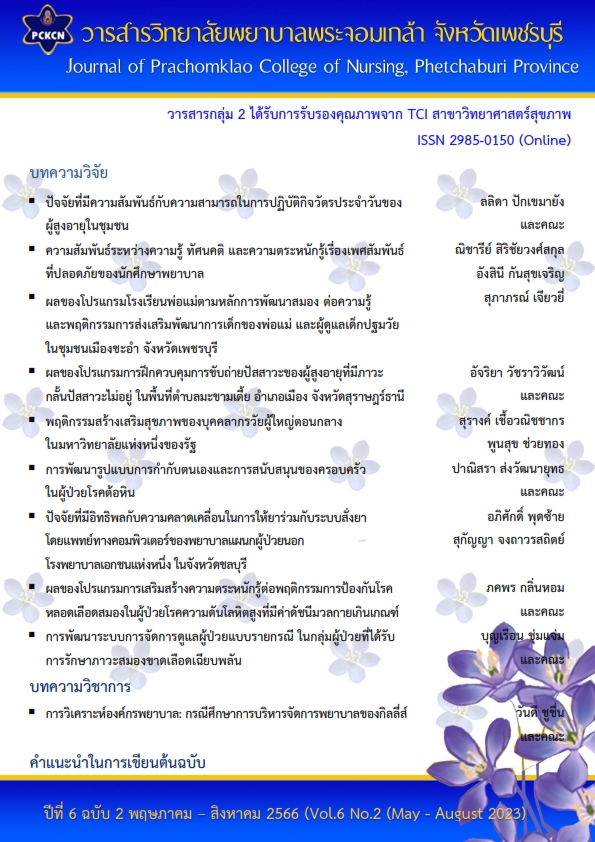ปัจจัยที่มีอิทธิพลกับความคลาดเคลื่อนในการให้ยาร่วมกับระบบสั่งยาโดยแพทย์ ทางคอมพิวเตอร์ ของพยาบาลแผนกผู้ป่วยนอก โรงพยาบาลเอกชนแห่งหนึ่ง ในจังหวัดชลบุรี
Main Article Content
บทคัดย่อ
การวิจัยเชิงพรรณนา มีวัตถุประสงค์เพื่อศึกษาปัจจัยที่ทำนายความคลาดเคลื่อนในการให้ยาของพยาบาลแผนกผู้ป่วยนอกร่วมกับระบบการสั่งยาโดยแพทย์ทางคอมพิวเตอร์ กลุ่มตัวอย่างเป็นพยาบาลแผนกผู้ป่วยนอกของโรงพยาบาลเอกชนแห่งหนึ่ง จำนวน 92 คน เก็บรวบรวมข้อมูลโดยใช้แบบสอบถามปัจจัยภายในตัวบุคคล ปัจจัยด้านสิ่งแวดล้อมในสถานที่ปฏิบัติงาน และประสบการณ์ในการให้ยาคลาดเคลื่อนร่วมกับระบบการสั่งยาโดยแพทย์ทางคอมพิวเตอร์ วิเคราะห์ข้อมูลทั่วไปด้วยสถิติพรรณนา และวิเคราะห์การถดถอยโลจิสติก
ผลการวิจัยพบว่า พยาบาลแผนกผู้ป่วยนอก โรงพยาบาลเอกชนแห่งหนึ่ง ในจังหวัดชลบุรี มีการให้ยาร่วมกับระบบสั่งยาโดยแพทย์ทางคอมพิวเตอร์คลาดเคลื่อน ร้อยละ 20.65 ปัจจัยที่ร่วมทำนายความคลาดเคลื่อนในการให้ยาของพยาบาลแผนกผู้ป่วยนอกร่วมกับระบบการสั่งยาโดยแพทย์ทางคอมพิวเตอร์ ได้แก่ การสื่อสารระหว่างทีมสหสาขาวิชาชีพ (ORadj = 8.44, 95%CI: 1.46 – 48.15, p < .05) และการมีความซับซ้อนของผู้ป่วยที่ดูแลและการทำงานที่ไม่หยุดนิ่ง (ORadj = 9.66, 95%CI: 2.07 – 44.92, p < .01) ซึ่งสามารถร่วมกันทำนายโอกาสในการเกิดความคลาดเคลื่อนในการให้ยาของพยาบาลแผนกผู้ป่วยนอกร่วมกับระบบการสั่งยาโดยแพทย์ทางคอมพิวเตอร์ โรงพยาบาลเอกชนแห่งหนึ่ง ในจังหวัดชลบุรี ได้ร้อยละ 26.30
การวิจัยนี้สนับสนุนว่า โรงพยาบาลควรบรรจุเนื้อหาเกี่ยวกับการให้ยาร่วมกับระบบสั่งยาโดยแพทย์ทางคอมพิวเตอร์ลงในหลักสูตรอบรมสำหรับบุคลากร รวมทั้ง พัฒนาการสื่อสารระหว่างทีมสหสาขาวิชาชีพ และการจัดการทางพยาบาลในการดูแลผู้ป่วยที่มีความซับซ้อน เพื่อลดความคลาดเคลื่อนในการให้ยาและการบริการที่มีประสิทธิภาพสูงสุด
Downloads
Article Details

อนุญาตภายใต้เงื่อนไข Creative Commons Attribution-NonCommercial-NoDerivatives 4.0 International License.
เนื้อหาและข้อมูลที่เผยแพร่ในวารสารวิทยาลัยพยาบาลพระจอมเกล้า จังหวัดเพชรบุรี ถือเป็นข้อคิดเห็นและความรับผิดชอบของผู้นิพนธ์บทความโดยตรง บทความ เนื้อหา ข้อมูล รูปภาพ ฯลฯ ที่ได้รับการเผยแพร่ในวารสารนี้ ถือเป็นลิขสิทธิ์ของวารสารฯ หากบุคคลหรือหน่วยงานใดต้องการนำทั้งหมดหรือส่วนหนึ่งส่วนใดไปเผยแพร่หรือเพื่อกระทำการใด ๆ จะต้องอ้างอิงวิทยาลัยพยาบาลพระจอมเกล้า จังหวัดเพชรบุรี ทุกครั้ง
เอกสารอ้างอิง
Ambwani, S., Misra, A. K., & Kumar, R. (2019). Medication errors: Is it the hidden part of the submerged iceberg in our health-care system?. International Journal of Applied and Basic Medical Research, 9(3), 135-142.
Amiri, P., Rahimi, B., & Khalkhali, H. R. (2020). Nurses' attitudes toward computerized provider order entry (CPOE) system: A feasibility study prior to implementation. Journal of Clinical Research in Paramedical Sciences, 9(2), Article e101420. https://doi.org/10.5812/jcrps.101420
Aziz, N. G., Osman, G. A., & Rasheed, H. A. (2018). Nurses’ experiences and perceptions of medication administration errors. Zanco Journal of Medical Sciences, 22(2), 217-226. https://doi.org/10.15218/zjms.2018.029
Bangkok Pattaya Hospital. (2019) Medication error management policy of Bangkok Pattaya Hospital. Bangkok Pattaya Hospital. (in Thai)
Best, J. W. (1977). Research in education (3rd ed.). Prentice-Hall.
Bloom, B. S. (1971). Handbook on formative and summative evaluation of student learning. McGraw-Hill.
Hayavi-haghighi, M. H., Alipour, J., & Dehghani, M. (2021). Nursing errors and Computerized Provider Order Entry (CPOE). Informatics in Medicine Unlocked, 25, Article 100648. https://doi.org/10.1016/j.imu.2021.100648
Korb-Savoldelli, V., Boussadi, A., Durieux, P., & Sabatier, B. (2018). Prevalence of computerized physician order entry systems–related medication prescription errors: A systematic review. International Journal of Medical Informatics, 111, 112-122. https://doi.org/10.1016/j.ijmedinf.2017.12.022
Krejcie, R. V., & Morgan, D. W. (1970). Determining sample size for research activities. Educational and psychological measurement, 30(3), 607-610.
Larouzée, J., & Guarnieri, F. (2015). From theory to practice: itinerary of Reasons’ Swiss Cheese Model. In ESREL 2015, European Safety and Reliability Association (ESRA) (pp. 817-824). HAL Open Science. https://hal-mines-paristech.archives-ouvertes.fr/hal-01207359
Lemeshow, S., Hosmer, D. W., Klar, J., Lwanga, S. K., & World Health Organization. (1990). Adequacy of sample size in health studies. Wiley.
Lerdsirisopon, S., Angkasuvan, W., Viengteerawat, S., Limapichat, R., Prapongsena, P., Ariyanuchitkul, T., Lapisatepun, W., Boonsombat, T., Sintavanuruk, K. & Chongarunngamsang, W. (2018). Medication errors and adverse drug events: Analysis from perioperative anesthetic adverse events in Thailand (PAAD Thai study). Journal of the Medical Association of Thailand, 101(6), 829-836. (in Thai)
Liang, M. Q., Thibault, M., Jouvet, P., Lebel, D., Schuster, T., Moreault, M. P., & Motulsky, A. (2023). Improving medication safety in a paediatric hospital: A mixed-methods evaluation of a newly implemented computerised provider order entry system. BMJ Health & Care Informatics, 30(1), Article e100622. https://www.ncbi.nlm.nih.gov/pmc/articles/PMC9930550/pdf/bmjhci-2022-100622.pdf
Parry, A. M., Barriball, K. L., & While, A. E. (2015). Factors contributing to registered nurse medication administration error: A narrative review. International Journal of Nursing Studies, 52(1), 403-420.
Sabzi, Z., Mohammadi, R., Talebi, R., & Roshandel, G. R. (2019). Medication errors and their relationship with care complexity and work dynamics. Open Access Macedonian Journal of Medical Sciences, 7(21), 3579-3583. https://doi.org/10.3889/oamjms.2019.722
Steven, J. (1996). Applied multivariate statistics for the social sciences (6thed.). Routledge.
Tariq, R. A., Vashisht, R., Sinha, A., & Scherbak, Y. (2023, 2 May). Medication dispensing errors and prevention. National Library of Medicine. https://www.ncbi.nlm.nih.gov/books/NBK519065/
The Healthcare Accreditation Institute. (2020). The 2nd world patient safety day and the 4th Thailand patient and personnel safety day. The Healthcare Accreditation Institute. (In Thai)
Vicente Oliveros, N., Gramage Caro, T., Pérez Menéndez‐Conde, C., Álvarez‐Diaz, A. M., Martín‐Aragón Álvarez, S., Bermejo Vicedo, T., & Delgado Silveira, E. (2017). A continuous usability evaluation of an electronic medication administration record application. Journal of Evaluation in Clinical Practice, 23(6), 1395-1400.
Wondmieneh, A., Alemu, W., Tadele, N., & Demis, A. (2020). Medication administration errors and contributing factors among nurses: A cross sectional study in tertiary hospitals, Addis Ababa, Ethiopia. BMC Nursing, 19(1), Article 4. https://doi.org/10.1186/s12912-020-0397-0
World Health Organization. (2014). Reporting and learning systems for medication errors: The role of pharmacovigilance centres. World Health Organization. https://apps.who.int/iris/handle/10665/137036
World Health Organization. (2017, 29 March). WHO launches global effort to halve medication-related errors in 5 years. https://www.who.int/news/item/29-03-2017-who-launches-global-effort-to-halve-medication-related-errors-in-5-years


